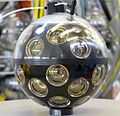KM3NeT

KM3NeT, an acronym for Cubic Kilometre Neutrino Telescope, is a future European research infrastructure that will be located at the bottom of the Mediterranean Sea. It will host the next generation neutrino telescope in the form of a water Cherenkov detector with an instrumented volume of more than five cubic kilometres distributed over three locations in the Mediterranean: KM3NeT-Fr (off-shore Toulon, France), KM3NeT-It (off-shore Portopalo di Capo Passero, Sicily, Italy) and KM3NeT-Gr (off-shore Pylos, Peloponnese, Greece).
KM3NeT will search for neutrinos from distant astrophysical sources like supernova remnants, gamma-ray bursts, supernovae or colliding stars and will be a powerful tool in the search for dark matter in the universe. Its prime objective is to detect neutrinos from sources in our Galaxy. Arrays of thousands of optical sensor modules will detect the faint light in the deep sea from charged particles originating from collisions of the neutrinos and the water or rock in the vicinity of the detector. The research infrastructure will also house instrumentation for other sciences like marine biology, oceanography and geophysics for long term and on-line monitoring of the deep sea environment and the sea bottom at depth of several kilometres.
The full neutrino telescope will contain in the order of 12000 pressure-resistant glass spheres attached to about 600 strings - vertical structures with a height of almost one kilometer. Each glass sphere will contain 31 photomultiplier tubes and will be connected to shore via a high-bandwidth optical network. At the shore of each KM3NeT installation site, a farm of computers will perform the first data filter in the search for the signal of cosmic neutrinos, prior to streaming the data to a central KM3NeT data centre for storage and further analysis by the KM3NeT scientists.
In 2012, the first phase of the implementation of the KM3NeT research facility has started with the construction of the seabed infrastructure at the KM3NeT-Fr and KM3NeT-It sites. Since early 2013, a prototype KM3NeT Digital Optical Module (KM3NeT-DOM) is operational in the ANTARES telescope. At the KM3NET-It site the first prototype KM3NeT-string is operational since the early spring of 2014.
For the design of the neutrino detector, KM3NeT builds on the experience of three pilot projects in the Mediterranean Sea: the ANTARES detector, the NEMO experiment and the NESTOR Project. ANTARES was completed on 30 May 2008, and is the largest neutrino telescope in the northern hemisphere.
In the southern hemisphere, at Antarctica, the IceCube Neutrino Observatory is already operational. Together, IceCube and KM3NeT will view the full sky and form a global neutrino observatory.
-

Artist's impression of the KM3NeT neutrino telescope anchored to the seabed.
-

KM3NeT Digital Optical Module (DOM) in the laboratory.
-

Electronics to readout the photomultiplier tubes and calibration instrumentation inside the KM3NeT DOM.
-

The KM3NeT LOM – the Launching vehicle of Optical Modules - being loaded onto the RV Pelagia deployment vessel. A full string detection is rolled onto the LOM. After arrival at the seabed the string is unrolled to its full length.
-

A prototype KM3NeT DOM installed in the instrumentation line of the ANTARES neutrino telescope. The DOM is operational since April 2013.
All pictures shown are propriety of the KM3NeT Collaboration
References
| ||||||||||||||||||||||||||||||